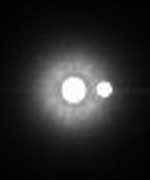Genesis team scientists and engineers continue their work on the mission’s sample return canister in a specially constructed clean room at the U.S. Army Proving Ground in Dugway, Utah. As more of the capsule’s contents are revealed, the team’s level of enthusiasm for the amount of science obtainable continues to rise.
At present, the science canister that holds the majority of the mission’s scientific samples is lying upside down – on its lid. Scientists are very methodically working their way “up” from the bottom portion of the canister by trimming away small portions of the canister’s wall. The team continues to extract, from the interior of the science canister, small but potentially analyzable fragments of collector array material. One-half of a sapphire wafer was collected Tuesday – the biggest piece of collector array to date.
The mission’s main priority is to measure oxygen isotopes to determine which of several theories is correct regarding the role of oxygen in the formation of the solar system. Scientists hope to determine this with isotopes collected in the four target segments of the solar wind concentrator carried by the Genesis spacecraft. The condition of these segments will be better known over the next few days, after the canister’s solar wind concentrator is extricated. At this time, it is believed that three of these segments are relatively intact and that the fourth may have sustained one or more fractures. There are no concrete plans regarding the shipping date of the Genesis capsule or its contents from Dugway to the Johnson Space Center in Houston. The team continues its meticulous work and believes that a significant repository of solar wind materials may have survived that will keep the science community busy for some time.
The Genesis sample return capsule landed well within the projected ellipse path in the Utah Test and Training Range on Sept. 8, but its parachutes did not open. It impacted the ground at nearly 320 kilometers per hour (nearly 200 miles per hour).
News and information about Genesis is available on the Internet at http://www.nasa.gov/genesis. For background information about Genesis, visit http://genesismission.jpl.nasa.gov. For information about NASA on the Internet, visit http://www.nasa.gov.
Original Source: NASA/JPL News Release

